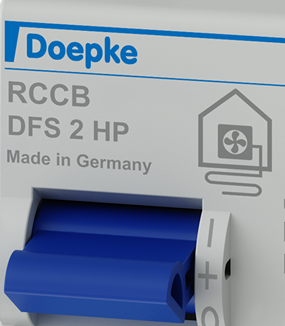Heat Pumps (HP) producing leakage currents above 1kHz, will not be compatible with Type B RCDs that are only manufactured to meet the lowest requirement of BSEN62423 i.e. operation up to 1kHz.

RCCB suitable for HP application < 20kHz
Marking the RCCB with HP symbol aids identification on site
Type B RCDs rated for use up to 1kHz may trip unexpectedly when subjected to leakage currents above 1kHz, or worse, the detection circuit may be saturated (blinded). This will result in the device not detecting residual currents under fault conditions.
BS7671 offers essential guidance for the design of the installation for those who have the experience to ask the right questions. If unsure, the “skilled person” will seek the advice of the HP and RCD manufacturers to verify that the characteristics of the equipment they intend to use are compatible.
Compatibility of Characteristics – Ref BS 7671 331.1
BS7671 states “An assessment shall be made of any characteristics of equipment likely to have harmful effects upon other electrical equipment.”

Leakage current in AC circuits is an inherent function of circuit capacitance and increases as a function of frequency. Modern HPs, to improve efficiency, apply inverter technology with switching frequencies in the kHz range.
HP leakage current and the associated harmonic currents must not have a detrimental effect on the protection offered by the RCD, and the RCD should not trip as a result of normal circuit leakage current.
Compared to normal domestic equipment designed to be plugged into a 13A socket, HPs contain larger inverters, the characteristics of which must be considered when designing the installation. Installers who have not been involved in commercial or industrial applications may not have had experience with this type of equipment or the application of Type B RCDs.
If you have no experience with HP installations, do not make assumptions about the installation requirements. Before quoting and buying products, check with the HP and RCD manufacturers to verify the RCD characteristics for use with the HP model.
Type B for use with HPs – Understanding the standards
At the time of writing, BS7671 Appendix 1 refers to BSEN62423 2012 for Type B: To claim compliance, RCDs do not have to work above 1 kHz. The VDE standard 0664-400 (B+) sets an upper limit of 20 kHz.*
This is a recognised issue for larger inverter applications, usually associated with non-domestic installations. Doepke and several European manufacturers Type B RCDs exceed the requirements of the existing BSEN. Consequently, for applications exceeding the 1kHz value (see clause 133.1.1), reference must be made to the individual manufacturer’s Type B RCD characteristics, to check their suitability for HP applications.
The diagram below gives an example of two 30mA Doepke Type B characteristics for use with Heat Pumps.
(Red dashed line shows the existing 1kHz requirement for BSEN 624232)

-
Grey shaded area: Tripping characteristic for DFS. HP and DFS. BSK
-
Blue dashed line: Limit of operation for DFS HP < 20 kHz; VDE 0664-400 B+
-
Green dashed line: HP leakage currents > 20 kHz use the BSK; based on IEC 60479-2
-
Example: If 150 mA leakage current at say 4 kHz flows in the circuit it should not trip the RCD
*The performance limit for an RCD with regard to frequency, is a function of the quality and properties of the magnetic materials and the design of detection circuits used in the product:
Low < 1kHz, Medium < 20kHz, High < 150kHz.
Characteristics above 1kHz are based on extrapolation of the tripping requirements in 62423 and the
advice /limits given in IEC60479-2 thresholds < 150 kHz. 30 mA BSK characteristic is within the threshold for ventricular fibrillation < 150kHz / IEC60947-2.
Conclusion
Greener homes require more innovative solutions (equipment) than those traditionally associated with the simplicity of our old domestic installations. This intern needs more knowledge of the characteristics of the equipment we intend to supply with electricity. Planning, checking, and verification before attending the site are prerequisites for quick, safe, and reliable installation.
The requirements for skilled electrical installers are given in BS7671. Manufacturers such as Doepke publish characteristics for their Type B RCCBs; these can be used to verify that they are compatible with the HP model. HP manufacturers who do not provide a clear statement on RCD compatibility requirements risk costly rework when things go wrong.
Besides safety, using inappropriate products in the HP installation will result in system availability issues. This, in turn, affects the image of the HP Brand, the companies involved in the installation, and the final customer.
As with any complex equipment, HP characteristics vary from one manufacturer to another. Consequently, the design of the electrical supply requirements and associated protection devices may differ. This must be considered with the individual site design requirements based on BS7671.
Remember, look, check, ask, think, do.
Chaz Andrews – Technical Manager, Doepke UK Ltd
